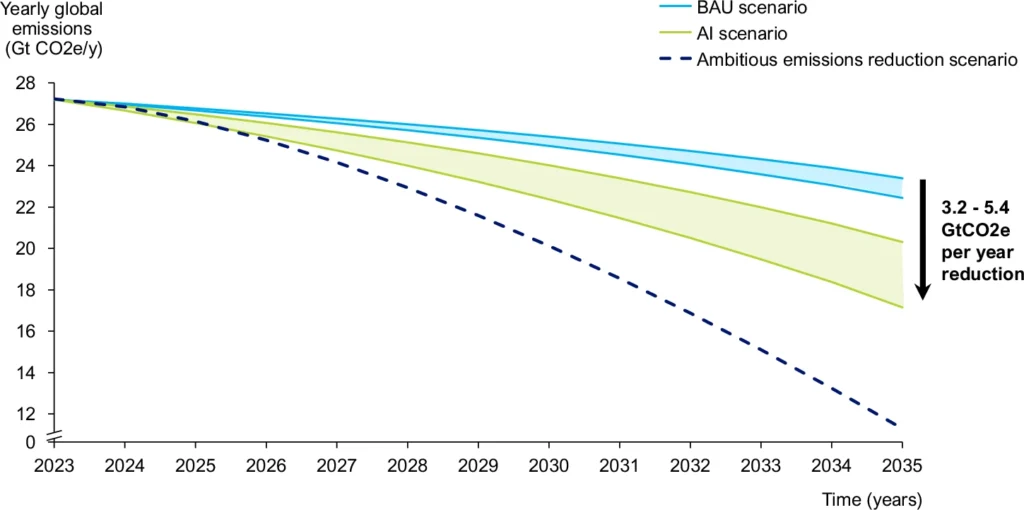Many worry about the energy appetite of generative AI. Sam Altman recently wrote that a single ChatGPT query uses about 0.34 Wh, roughly what a high‑efficiency LED burns in a couple of minutes. Scale that to billions of queries and the power draw of data centres quickly becomes a climate headline.
A Nature study published in June 2025 argues that smart, sector‑specific AI could cut 3.2–5.4 gigatonnes of CO₂‑equivalent per year (Gt CO2e) by 2035 across power, food and transport. A Financial Times coverage highlights the same upside but warns that real‑world deployment still lags the lab results.
Below is a quick tour through the upside, the footprint, the hype filter and the imperatives for greener AI.
1. The upside: five levers worth about 5 gigatonnes
- Smarter grids and traffic: AI predicts demand, balances renewables and unclogs city roads.
- Better batteries and less waste: generative models speed up chemistry search and trim packaging.
- Greener everyday choices: tools like Google Maps eco‑routes nudge users to save fuel.
- Sharper climate forecasts: high‑resolution models warn of floods and droughts sooner.
- Faster disaster response: early warnings for fires and storms protect people and assets.
Focusing on power, food and mobility alone, Stern et al. estimate AI could avoid up to 5.4 Gt CO₂e each year, roughly three times AI’s own projected emissions.

2. The footprint: rising fast
The IEA predicts that data centre electricity demand will more than double to about 945 TWh by 2030, with AI the biggest driver. That is similar to Japan’s entire grid today.
Key points:
Location matters: Training on a Belgian winter night fed by offshore wind is cleaner than a sunny Texas afternoon on a coal-heavy grid.
Water consumption is a hidden cost: AI’s footprint isn’t just carbon. Data centres consume vast amounts of fresh water for cooling. The Nature study highlights this, calling for transparent reporting of water usage alongside energy and emissions.
Model size is not free: A ten times larger model can need ten to twenty times more energy for marginal gains.
Hardware and cooling: Liquid cooling and faster GPUs buy time but do not solve the problem alone.
3. The hype filter: lessons from the FT
The Financial Times’ Pilita Clark notes that prototypes wow investors, but messy field conditions and thin margins derail many climate AI pilots. Meta’s CO₂ capture model, for example, unravelled under peer review.
4. Green AI in practice: Four imperatives
Track and disclose emissions both sources call for transparent reports of model energy, carbon and water use.
Aim at high impact sectors deploy scarce GPUs where decarbonisation gains are largest, namely power, food and mobility.
Test outside the lab validate with live data and publish uncertainties to close the lab to market gap.
Adopt efficient tech NVIDIA Blackwell GPUs promise up to twenty five times better energy per token than H100s, and Mixture of Experts routing can cut inference energy by about seventy percent.
5. Policy: the active state angle
Markets alone will not prioritise low profit high impact climate applications. The Nature paper suggests governments should:
Mandate lifecycle emissions disclosure for cloud and model providers.
Offer time of use rebates for AI workloads that align with renewable peaks.
Fund open climate AI datasets and benchmarks to de risk early research.
Bottom line
AI can be a climate multiplier, but only if we measure its footprint, steer GPUs toward the biggest carbon wins and adopt the efficiency tech already on the roadmap.
Ready to stress test your own AI energy budget? Contact us; we can measure your AI climate impact and optimise it for a lighter footprint.





